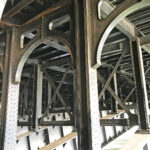August 16, 2019. Feathers and Fate
In chapter six of my book I talk about some of the scenarios pilots fear. This pilot, at any rate. They’re generally not things the traveling public would expect. A tire burst and takeoff abort at high runway speed, for example. Or a lithium-sparked cargo fire. Or birds.
Bird strikes are common, and the damage tends to be minor or nonexistent — unless you’re looking at it from the bird’s point of view. And as you’d expect, aircraft components are built to tolerate such impacts. I’ve personally experienced several strikes, and the result was, at worst, a minor dent or crease. I should hardly have to mention, however, that strikes are occasionally dangerous.
This is especially true when engines are involved. Modern turbofans are resilient, but they don’t take kindly to the ingestion of foreign objects, particularly those slamming into their rotating blades at high speeds. Birds don’t clog an engine but can bend or fracture the internal blades, causing power loss. The heavier the bird, the greater the potential for harm. Flying at 250 knots—in the United States — that’s the maximum allowable speed below 10,000 feet, where most birds are found — hitting an average-sized goose will subject a plane to an impact force of over 50,000 pounds. My big fear is such an impact causing power loss or engine failure at or near takeoff speed, requiring a high-speed abort. No less scary would be the same thing happening just after takeoff, potentially resulting in an off-airport landing or a crash.
That’s exactly what happened in 2009 when US Airways flight 1549 glided into the Hudson River after colliding with a flock of Canada geese. And, on Thursday, it happened again. Ural Airlines flight 178, an Airbus A321 with over two-hundred people aboard, went down seconds after takeoff from Moscow’s Zhukovsky International Airport. Mobile phone footage shot by passengers shows the jet colliding with a flock of seagulls as it becomes airborne. The impact severely damaged both engines, forcing the pilots to glide into a cornfield just off the runway.
As with the Sully-upon-Hudson splashdown in 2009, there were no fatalities. Also in both cases, pilot skill played a comparatively minor role. It was luck, more than anything, that saved the day: daylight, clear weather, and a smooth, obstruction-free spot for the pilots to aim for.
Your next question, then, is why aren’t engines built with protective screens in front?
Well, in addition to partially blocking the inflow of air, the screen would need to be large (presumably cone-shaped) and very strong. And should it fail, now you’re sucking in a bird and pieces of metal.




